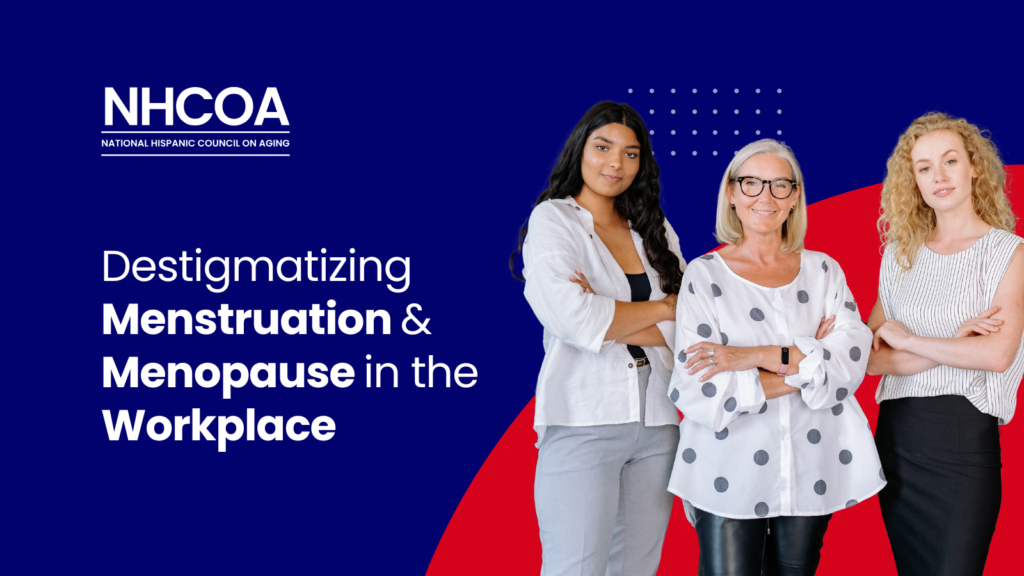
October 18th, 2024, was World Menopause Day, a day intended to spread awareness of menopause and drive forward conversations to destigmatize it.
Ahead of World Menopause Day, in September, the Women’s Bureau of the U.S. Department of Labor released a briefing titled, “Let’s Talk About It: Menstruation and Menopause at Work.” The briefing specifically detailed accommodations and legal protections for employees’ experience of menstruation and menopausal symptoms, and made clear the necessity to destigmatize and understand these biological processes as medical conditions.
The National Hispanic Council on Aging applauds the efforts made by the Women’s Bureau, as well as fellow organizations working to improve awareness of both menstruation and menopause. A person living with a uterus is guaranteed to experience both menstruation and menopause at some point in their life, along with symptoms that vary from person to person. These symptoms can cause extreme discomfort, and even keep one from being able to work effectively; to lay expectations upon an employee that they must simply endure and still provide their typical performance at work is tantamount to discrimination on the basis of medical condition, sex characteristics, and even age.
It’s important to arm yourself with the knowledge to advocate for your medical conditions. Read on for helpful information and tips on your rights within the workplace, when it comes to your menstruation and menopausal symptoms.
Do you know what constitutes workplace harassment as defined by the U.S. Dept of Labor?
According to the U.S. Dept of Labor, harassment is defined as unwelcome verbal, written, or physical conduct that is based on:
| · Race · Color · Ancestry · National Origin · Religion · Physical or Mental Disability · Medical Condition · Genetic Information · Sex · Lactation · Abortion · Sexual Orientation | · Transgender Status · Gender Identity · Gender Expression · Intersex Traits · Sex Stereotyping · Sex Characteristics · Age (40 and Up) · Parental status · Marital Status · Military or Veteran Status · Citizenship · Political Affiliation or Belief |
Harassment is further elaborated to include “behaviors that can reasonably be considered to adversely affect the work environment, particularly if allowed to continue (that is, potentially giving rise to a “hostile work environment”).”
What does the Women’s Bureau advise, knowing the terms set by the Dept of Labor?
In their recent briefing, the Women’s Bureau wisely points out that there is no explicitly defined protection against discrimination based on menstruation or menopause. However, they do suggest that the employee is likely still protected “by laws and regulations prohibiting employment discrimination, including harassment, on the basis of age, sex, disability or a combination of these characteristics.”
As we can see in the terms set by the Dept. of Labor, employees cannot be harassed or discriminated against on the basis of a medical condition, their sex, their sex characteristics, their age, or disability. As it happens, menstruation and menopause are both medical conditions and sex characteristics; menopause is also known to occur in middle-age and thereafter (40 and up).
The Women’s Bureau takes this a step further, and advises that some instances of symptoms experienced during menstruation and/or menopause “may meet the definitions outlined in federal laws such as the American with Disabilities Act (ADA).” In fact, the ADA defines the term “disability” as the following:
(A) a physical or mental impairment that substantially limits one or more major life activities of such individual;
(B) a record of such an impairment; or
(C) being regard as having such an impairment
The ADA further elaborates that major life activities include:
| · Caring for oneself · Performing Manual Tasks · Seeing or hearing · Eating · Sleeping · Walking · Standing · Lifting · Bending · Speaking · Breathing | · Learning · Reading · Concentrating · Thinking · Communicating · Working · Major Bodily Functions, including: – Bowel – Bladder – Reproductive Functions |
The emboldened terms clearly relate to many of the symptoms that are common to both menstruation and menopause. The explicit mention of impairment regarding one’s reproductive functions is also undeniably related. Not all those who experience menstruation or menopause will experience symptoms so severe that they would be considered a disability, but many do.
These definitions and terms are simply the tip of the iceberg. For more information on your rights and protections in the workplace regarding the difficult symptoms of menstruation and menopause, consider the list of resources below:
– The Office on Women’s Health
– The United States Equal Employment Opportunity Commission
– The U.S. Dept. of Labor, Women’s Bureau
And, for a brief overview of Menopause, Perimenopause, and related symptoms, please consult our earlier blog post on the subject, here.
It all starts with knowing the facts; together, we can end the stigma attached to menstruation and menopause.
References:
– “U.S. Department of Labor Policy Statement on Harassing Conduct in the Workplace,” Office of the Assistant Secretary of Administration & Management. U.S. Dept. of Labor. https://www.dol.gov/agencies/oasam/centers-offices/civil-rights-center/internal/policies/DOL-Policy-Statement-on-Harassing-Conduct-in-the-Work
– “Let’s Talk About It: Menstruation and Menopause,” Issue Brief, Women’s Bureau. September, 2024. The U.S. Dept. of Labor. https://www.dol.gov/sites/dolgov/files/OPA/MenstruationAndMenopauseAtWork.pdf

Recent Comments